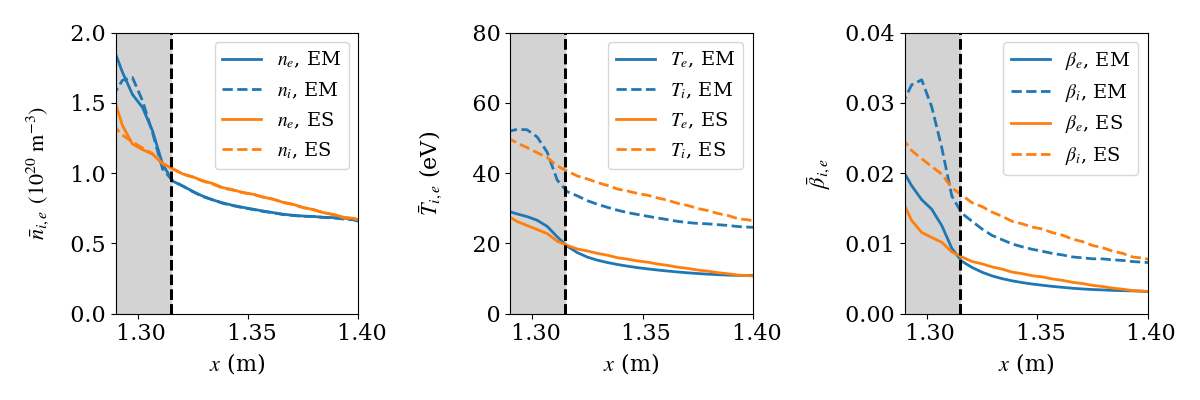Speaker
Description
In this paper we will present nonlinear full-$f$ electromagnetic gyrokinetic simulations of turbulence in the pedestal and scrape-off layer (SOL) region of a tokamak. The algorithms in the Gkeyll code solve the electromagnetic gyrokinetic equations using a continuum high-order discontinuous Galerkin scheme. The equations are written in a sympletic form in which the particle parallel momentum is used as a coordinate. The details of our algorithms are presented in[1,2], with previous work in simulating electrostatic turbulence in in helical SOL plasmas in[3,4]. As far as we are aware, these are the \emph{first} fully nonlinear full-$f$ electromagnetic simulations in the high-$\beta$ regime on open field-lines.
Our setup is a helical, open field-line model of a NSTX-like SOL. We use a non-orthogonal field-aligned coordinate system. The simulation domain is a flux-tube on the outboard side that wraps helically around the torus, with the field-lines intersecting metal divertor plates on either ends. The interaction of the plasma with the divertor plate is modeled using a sheath boundary condition which allows current fluctuations into and out of the divertor plates.(The results presented in this abstract focus on the SOL with a helical model, but we have extended the code to general geometry sufficient for a pedestal and SOL with a limiter, with X-point capabilities available soon.) The simulation parameters approximate SOL conditions in an H-mode deuterium plasma: $B_\text{axis}=0.5$ T, $R_0=0.85$ m, $a=0.5$ m, $T_{e0}=T_{i0}=40$ eV. (The plasma $\beta$ is enhanced by a factor of 10 relative to the steady-state experiment to show the robustness of the algorithm, even for ELMs or or other high-$\beta$ transients.) The plasma core supplies a particle source for the SOL.



The bad curvature drive causes interchange instabilities in which blobs are ejected intermittently radially outwards. This is seen in the density contours in Fig.1 in which mushroom like structures appear. Significant magnetic fluctuations of around $2.5\%$ are seen in $|\delta B_\perp|/B_0$, greatly modifying the transport as compared to when the electromagnetic terms are neglected. In Fig.2 we show the radial profiles of density, temperature and beta for both electrons and ions. These are compared to the case in which the electromagnetic terms have been turned off. It is seen that in the ES case the profiles are shallower, indicating that the radial transport is less in the EM case. In general, the inclusion of the EM terms makes the turbulence more intermittent, significantly changing the transport in the high-$\beta$ regime. Even though the magnetic field-lines, Fig.3, are tied right at the divertor plates, they slip due to sheath resistance, and in the interior, fluctuate and reconnect as the blobs drag the field-lines in their outward motion. The results summarized here are for turbulence in the SOL.The extension of these results to include the pedestal physics also will be presented.
-
Ammar H. Hakim, Noah R. Mandell, T. N. Bernard, M. Francisquez, G. W. Hammett, E. L. Shi, "Continuum Electromagnetic Gyrokinetic Simulations of Turbulence in the Tokamak Scrape-Off Layer and Laboratory Devices", Submitted to Phys. Plasmas
-
Tess N Bernard, Eric L Shi, KW Gentle, Ammar Hakim, Gregory W Hammett, Timothy Stoltzfus-Dueck,and Edward I Taylor. "Gyrokinetic continuum simulations of plasma turbulence in the Texas Helimak". Phys. Plasmas, 26(4):042301, 2019
-
N R Mandell, A Hakim, G W Hammett, and M Francisquez. "Electromagnetic full-f gyrokinetics in the tokamak edge with discontinuous Galerkin methods", J. Plasma Phys., 86(1):905860109, 2020
-
Eric L Shi, Gregory W Hammett, Timothy Stoltzfus-Dueck, and Ammar Hakim. "Full-f gyrokinetic simulation of turbulence in a helical open–field–line plasma". Phys. Plasmas, 26(1):012307, 2019
| Affiliation | Princeton Plasma Physics Laboratory |
|---|---|
| Country or International Organization | United States |
